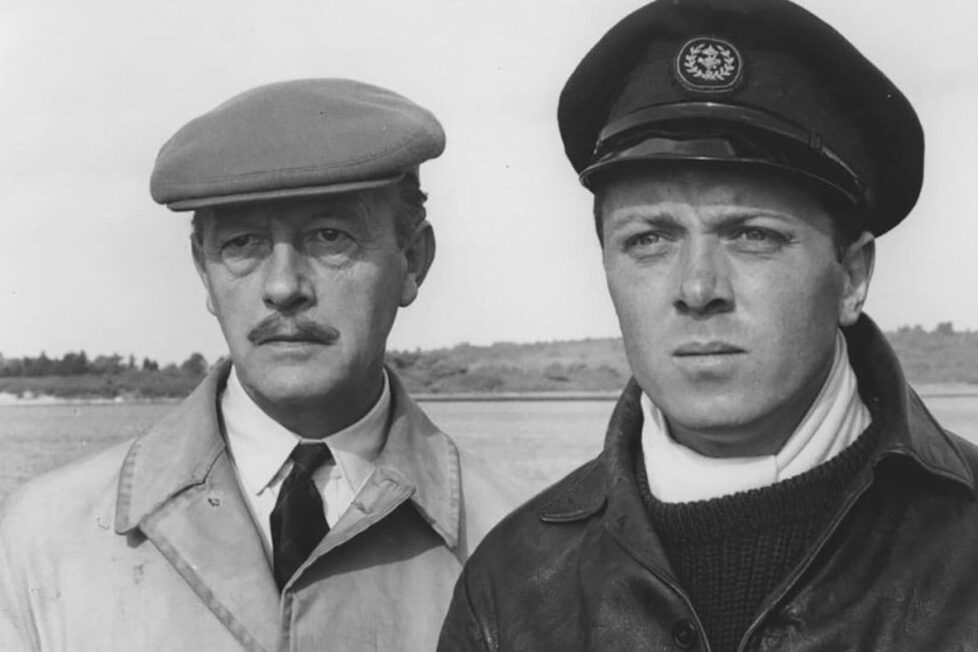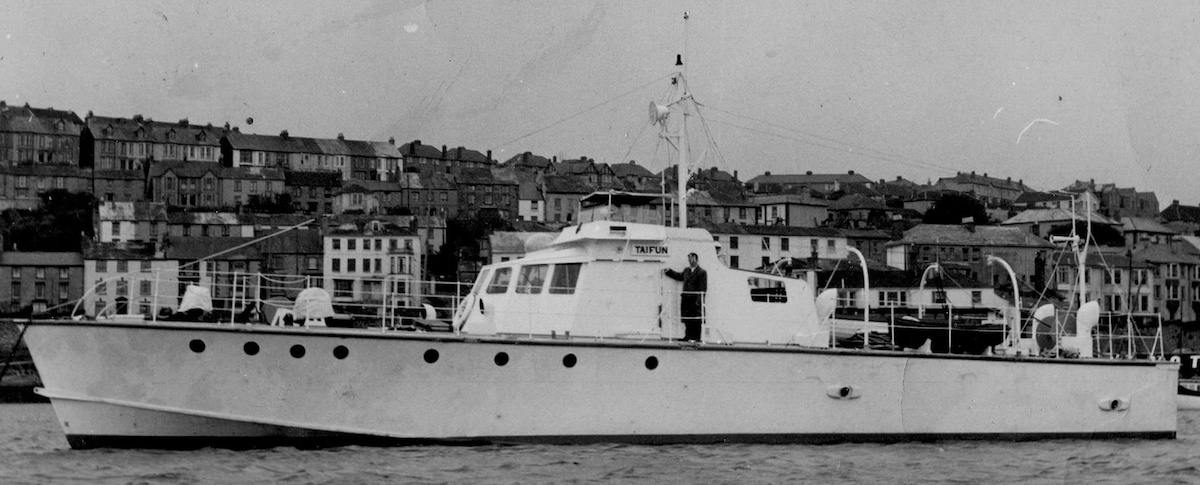THE SHIP THAT DIED OF SHAME (1955)
After World War II ends, a trio of former sailors turn to smuggling...

After World War II ends, a trio of former sailors turn to smuggling...


Basil Dearden’s Ealing Studios film The Ship That Died of Shame (also released under the blander, not to mention misleading, title PT Raiders) could easily be seen as a nautical noir. Its context is the disenchantment of ex-servicemen with the civilian lives they were plunged back into after the end of World War II; the enemy is no longer the Germans or the cruel sea itself but the privations of postwar austerity, and perhaps the lack of status and adventure too.
The moral journey the film portrays is very noir-ish (the descent of a good man into doing bad things, through weakness rather than dishonourable motivation), and while it’s notable for the almost complete absence of women, an inanimate object commonly referred to as female—the vessel of the title—is nearly a character itself.
Based on a Nicholas Monsarrat 1952 short story, The Ship That Died of Shame begins with a voiceover from Randall (George Baker), the commander of the 1087, a motor gunboat in Britain’s Royal Navy during WWII which runs short missions off the south coast of England. (Many of the exteriors on land were shot around Weymouth in Dorset.)
“Ships don’t have souls,” Randall says, but he’s clearly trying to convince himself of this and doesn’t quite believe it. The voiceover is implicitly spoken after the film’s ended, but this early section is still set during the war—built around an exciting cross-Channel raid—and here we also meet the more junior officer Hoskins (Richard Attenborough). StudioCanal has re-released the movie to celebrate what would have been Attenborough’s 100th birthday a couple of weeks ago.
It’s clear even this early that Hoskins is a chancer, wanting to claim a German plane they managed to hit as a kill (another exciting sequence) even though they don’t know for sure it went down. It’s also clear that Randall is made of more scrupulous stuff, and much of the storyline of The Ship That Died of Shame stems from this contrast between them.
Soon there’s a tragedy for Randall, which disposes of the only credited female in the entire cast (Virginia McKenna), and then the war ends too. Both these events set the stage for the main story…
Sometime later, after Randall’s started his own company and quickly saw it fail, he runs into Hoskins at a reunion, where the latter suggests that they go into business together… and buy the now-mothballed gunboat, 1087, in order to do it. Unsurprisingly, given what we already know of Hoskins, the business is smuggling… but he makes it sound like a victimless, even positively selfless, crime, arguing they’re only going to “lighten up the postwar darkness a bit” by bringing in nylons, brandy, and suchlike from the continent to England.
Randall agrees, though significantly (and Hoskins sees and exploits this) he’s lured into the scheme more by his desire to captain the 1087 again than by any criminal ambitions. So, too, is another member of the 1087’s former crew, Birdie (Bill Owen), and it’s not unreasonable to see their relationship with the ship as directly replacing the relationships with women that might be expected in most such movies. Randall’s initial discouragement of Birdie, trying to stop him from joining the smuggling enterprise, is presented as a concern to keep his former colleague out of trouble… but is it also a desire to have the 1087 to himself?
The ship-as-character eventually emerges more overtly as Hoskins’s illegal shipments become increasingly unsavoury: no longer just a few bottles of wine, but leftover Nazi counterfeit currency, then German guns, then finally an apparently monstrous criminal fleeing the police. Step by step, the cargo is becoming redolent of the defeated enemy.
Whether the ship actually does have a mind of its own, in seeming to protest against the increasingly sordid business it’s being forced into, is wisely left unexplored. This isn’t some bizarre naval precursor of The Love Bug (1969)!
Bosley Crowther, writing in The New York Times at the time of the film’s release, suggested 1087 might have been possessed by the spirit of a character who dies early on, but any supernatural explanation seems unnecessary. It’s every bit as credible to see the perceived truculence of the 1087 as being the product of guilt in Randall’s and Birdie’s minds. They know what they are doing is wrong, and therefore convince themselves that the ship they love shares the feeling.
And there is plenty of meat in the human performances without anthropomorphising.

Attenborough often steals the show, exuding psychopathy reminiscent of his Pinkie in Brighton Rock (1948). Equally striking is Roland Culver as the older, well-spoken, deeply unlikeable and possibly Nazi-sympathising Major Fordyce, with whom Hoskins forms a business arrangement. Fordyce sums up much of the film’s underlying sense of disappointment in postwar realities when he comments that he “got a bit tired of working for the plebs after fighting for them.”
John Chandos is hauntingly memorable as Raines, the criminal the trio are asked to help flee to France on the 1087. We know (assuming he’s guilty of his alleged crime) that he is an evil man; in appearance, he evokes Peter Lorre in Fritz Lang’s M (1931), which just could be intentional, and yet he comes across as more a victim than anything else, never speaking once, panic in his eyes.
In a completely different way, Harold Goodwin as a trainee customs officer (likewise never uttering a line) is amusing. He also introduces what turns out to be a pivotal, and unusual for the time, plot element: the role of two toilets, one the ship’s head, the other a gentlemen’s public convenience on shore. Though neither is seen, even referring to them and their operation so overtly is a curiosity.
Baker, unfortunately, is bland in his first lead role. His very limited experience in film shows and the character’s outbreak of high-mindedness toward the climax doesn’t ring true. Here, despite dialogue to the contrary, Baker’s acting doesn’t give us so much a ‘man who regrets what he’s done and is desperate to step back from it’, as a ‘man who believes he’s never done anything wrong in his life’. It doesn’t help, either, that for much of the movie, the character of Randall is so passive compared to Hoskins.
Owen, meanwhile, isn’t asked to do much more than be a salt-of-the-earth type, but he does it well enough.
William Alwyn, one of many “serious” English composers who also wrote for the screen around this time (in his case very prolifically), contributes an effective orchestral music score, especially good for the final fight sequence and earlier on at moments of suspense and mystery.
Strong contributions are made, too, by editor Peter Bezencenet, in particular his rapid edits in the opening raid and the fight at the end. And, of course, by director Dearden and cinematographer Gordon Dines. There are the occasional minor fumbles (some slightly obvious matte shots, and “sea spray” onto the decks of the 1087 that’s patently from a hose), but for the most part the visual storytelling, the handling of individual scenes, and the pacing—right up to a somewhat unexpected conclusion—are gripping.
The sequences at sea tend to be the best, though Fordyce’s office, crisscrossed with shadow like a mad scientist’s lab, is a visual delight in itself. Among the most impressive on the ship itself is one wordless scene at night, during heavy weather, where a pensive-looking Randall pushes a coffin into the sea. No explanation is offered, or needed. Equally atmospheric is another, longer night-time sequence where the 1087 is approached by a French patrol vessel, discernible only by voices coming through the fog.
The Ship That Died of Shame may not at first seem a subtle film, as evidenced by some of the dialogue. “That’s all over now,” Bernard Lee’s no-nonsense customs officer says firmly in reference to the war where he had had “a bit of a difference with a Jerry sub” as if to underline the point that the world has changed.
Similarly, Fordyce makes a contemptuous reference to “men of duty”, as if the audience wasn’t already well aware that he had repudiated any such sense himself.
But there’s more to it than meets the eye. It’s certainly not the standard-issue (if well-made) naval tale it might feel like at the beginning. As Neil Sinyard points out in his accompanying talk, there are no heroes here. And, far from excessively underlining, it often barely refers overtly at all to important points that it’s making.
Though the dislocation and redundancy felt by ex-servicemen is hinted at repeatedly (for example in the failure of Randall’s business, in his failure to get a job elsewhere, in Fordyce’s sneer at the “plebs”, and in the way that Hoskins effectively becomes senior to his former commander Randall now that they have left the Navy), there’s no lecturing on the subject.
The gap in values between the generations of Hoskins and Fordyce, too, is not mentioned outright but made obvious in a single gesture and a couple of lines. Nor is the sentience, if any, of the 1087 overdone.
The meanings of The Ship That Died of Shame are allowed to surface on their own, and while it’s perfectly watchable on a superficial level as a crime drama with nautical elements, it sticks in the mind as something much richer – another fine and undeservedly little-known non-comedy from Ealing.
UK | 1955 | 95 MINUTES | 1.37:1 | BLACK & WHITE | ENGLISH


director: Basil Dearden.
writers: Basil Dearden, Michael Relph & John Whiting (based on the short story by Nicholas Monsarrat).
starring: Richard Attenborough, George Baker, Bill Owen, Virginia McKenna, Roland Culver & Bernard Lee.
